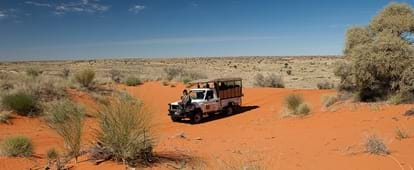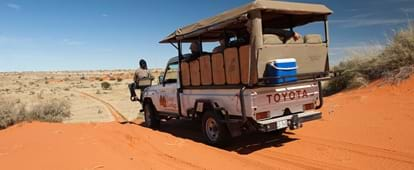By creating an account, I agree to the
Terms of service and Privacy policy
Choose your country and language:
Africa
Americas
Asia Pacific
Europe
TThe Kgalagadi Transfontier Park is a fusion of the former Kalahari Gemsbok National Park of South Africa, which was set up to protect migratory game such as Gemsbok, and the neighbouring Gemsbok National Park in Botswana.
These two wild wonderlands were separated by nothing but an unmarked international border. They form an ecological unit of some 37 000km² – a semi-desert wilderness of blonde grass, red dunes and enormous open spaces. All that was needed was to formalise the arrangement and coordinate ecology management. So in 2000, this became the first of South Africa's transfrontier ventures.
Authorities on both sides learnt much from the union, but tourists were the real winners, being able to move between the two parks, and thus two countries, without a passport (unless exiting on the other side, of course).

MManaging the ecology of the Kgalagadi Transfrontier Park as a single unit has been a great step forward for desert conservation. Plus, the opening of the border crossing at Mata Mata has opened more than just access between South Africa, Botswana and Namibia.
This gateway has started talks about creating a corridor linking this giant park to nearby Augrabies National Park, due south, and from there the Ai-Ais Richtersveld Transfrontier Conservation Area in the west. Just north of that is Namibia's 26 000km² Sperrgebiet National Park. That, in turn, abuts the Namib Naukluft National Park, one of the largest conservation areas in the world. If everything goes according to plan, they will all be linked in the near future.
Sustaining the spirit started by Kgalagadi may soon give rise to a mega-transfrontier park, protecting a desert storehouse of some of the most exquisitely adapted plants and animals on Earth. Proving that the African ethos of ‘Ubuntu’ – sharing with your neighbours – really is the way forward.

TTravel tips & planning info
Who to contact
SANParks reservations
Tel: +27 (0)12 428 9111
Kgalagadi Transfrontier Park
Tel: +27 (0)54 561 2000 (Twee Rivieren)
How to get there
From the Northern Cape town of Upington, head north to the Kgalagadi Transfrontier Park's gate at Twee Rivieren.
Best time to visit
Being a desert, temperatures are extreme. Summer (November to March) is searingly hot. Winter (June to August) is mild and pleasantly warm during the day but very cold at night. Spring and autumn are the most moderate and pleasant months.
Things to do
Various lodges and camps offer game-viewing drives and guided walks with park rangers.
What to pack
In summer, cool, loose clothes. In winter, bring the winter woolies for the evenings. Don't forget your camera and binoculars. And always bring a hat and sunscreen.
Where to stay
The South African side has a variety of self-catering and camping facilities. There's also a luxury lodge between Mata Mata and Twee Rivieren. Ask about the wilderness camps if you'd like an unfenced, more private experience. The Botswana side specialises more in rustic wilderness camping.
Related links

